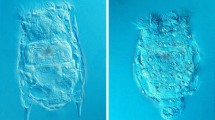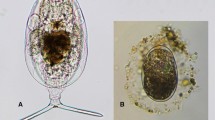Abstract
There are few quantitative data on the role of emergence from diapausing eggs in population dynamics of natural populations of zooplankton species; to our knowledge, all these concern copepods and ‘cladocerans’. We present here direct estimates of emergence from bottom resting eggs for another important category of freshwater zooplankton, namely rotifers. Three populations of rotifers of the genus Brachionus were studied in a lake. During the study period 10 population increases, each corresponding to an individual sampling interval, were detected. For each interval, emergence from immediately hatching, parthenogenetic eggs calculated on the basis of the Edmondson-Paloheimo model and emergence from diapausing bottom eggs determined in short-term experiments were estimated and compared to each other. We found that three of the population increases observed are entirely explained by parthenogenetic natality. In contrast, emergence from diapausing eggs can, on its own, account for none of population increases. For two population increases, however, it accounts for that part of population growth which remains unexplained by the parthenogenetic natality. For rotifer populations studied, emergence from diapausing eg eggs is generally less important than parthenogenetic births, when both are regarded as an immediate cause of population growth. This is in sharp contrast to the data available for some crustaceans (De Stasio, 1990) where the role of emergence from diapausing eggs in population dynamics has been clearly shown.
Similar content being viewed by others
References
Alekseev, V. R., 1990. Diapause in Crustaceans: Ecological and Physiological Aspects. Nauka, Moscow, 144 pp. (in Russian).
Bogoslovsky, A. S., 1969. Studying resting eggs of rotifers. Part 3. Bull. Mosk. Obshch. Ispyt. Prirody. Otd. Biol. 74 (3): 60–79 (in Russian).
Bottrell, H. H., A. Duncan, Z. M. Gliwicz, E. Grygierek, A. Herzig, A. Hillbricht-Ilkowska, H. Kurasawa, P. Larsson & T. Weglenska, 1976. A review of some problems in zooplankton production studies. Norw. J. Zool. 24: 419–456.
Chirkova, Z. N., 1975. Microzoobenthos. In F. D. Mordukhay-Boltovskoy (ed.), Methods of Studying Ecosystems of Iland Waters. Nauka, Moscow: 178–184 (in Russian).
De Stasio, B. T., Jr., 1990. The role of dormancy and emergence patterns in the dynamics of a freshwater zooplankton community. Limnol. Oceanogr. 35: 1079–1090.
De Stasio, B. T., Jr., 1989. The seed bank of a freshwater crustacean: copepodology for the plant ecologist. Ecology 70: 1377–1389.
De Stasio, B. T., Jr. & N. G. Hairson, Jr., 1992. Environmental variability and the persistence of multiple emergence strategies. Bull. math. Biol. 54: 313–334.
Downing, J. A., 1984. Chapter 4. Sampling the benthos ofstanding water. In J. A. Downing & F. H. Rigler (eds), A Manual on Methods for the Assessment of Secondary Productivity in Fresh Waters. Blackwell, Oxford: 87–130.
Edmondson, W. T., 1968. A graphical model for evaluatingthe use of the egg ratio for measuring birth and death rates. Oecologia 1: 1–37.
Hairston, N. G., Jr. & B. T. De Stasio, Jr., 1988. Rate of evolution showed by a dormant propagule pool. Nature (Lond.) 336: 239–242.
Hairstn, N. G., Jr. & W. R. Munns, Jr., 1984. The timing of copepod diapause as an evolutionary stable strategy. Am. Nat. 123: 733–751.
Hollowday, E. D., 1993. Recent world-wide studies in Rotiferology. Quekett J. Microscopy 37: 73–78.
Ishikawa, A. & A. Taniguchi, 1994. The role of cysts on population dynamics of Scrippsiella spp. (Dinophyceae) in Onagawa Bay, northeast Japan. Mar. Biol. 119: 39–44.
Kawabata, Z. & M. Ohta, 1989. Cyst distribution and excystment conditions for the dinoflagellate Peridinium penardii (Lemm.) Lemm. in a reservoir. Freshwat. Biol. 21: 437–444.
Lutz, R. V., N. H. Marcus & J. P. Chanton, 1992. Effects of low oxygen concentrations on the hatching and viability of eggs of marine calanoid copepods. Mar. Biol. 114: 241–247.
Marcus, N. H., 1984. Recruitment of copepod nauplii into the plankton: Importance of diapause eggs and benthic processes. Mar. Ecol. Prog. Ser. 15: 47–54.
Marcus, N. H., R. Lutz, W. Burnett & P. Cable, 1994. Age, viability, and vertical distribution of zooplankton resting eggs from an anoxic basin. Evidence of an egg bank. Limnol. Oceanogr. 39: 154–158.
May, L., 1987. Effect of incubation temperature on the hatching of rotifer resting eggs collected from sediments. Hydrobiologia 147: 335–338.
Mnatsakanova, E. A., 1990. Estimation of rotifer hatching from resting eggs in natural conditions. In L. A. Kutikova (ed.), Rotifera. Proceedings of the Third All-Union Rotifer Symposium. Zoological Institute, Leningrad: 33–41 (in Russian).
Mudretsova-Wiss, K. A., 1933. Effect of Carbonic Acid, Hydrogen Sulphide, Methane, and Lack of Oxygen on Aquatic Organisms. Gosstroyizdat, Moscow, 48 pp. (in Russian).
Paloheimo, J. E., 1974. Calculation of instantaneous birth rate. Limnol. Oceanogr. 19: 692–694.
Polishchuk, L. V., 1982. The “negative mortality” of planktonic animals and the sampling schedule. Zh. obshch. Biol. 43: 411–418 (in Russian).
Polishchuk, L. V., 1986. Dynamic Characteristics of Populations of Planktonic Animals. Nauka, Moscow, 128 pp. (in Russian).
Smirnova, I. A., 1985. Recruitment of rotifers due to hatching from resting eggs. In Biological Resources in Waters under Anthropogenic Stress. Naukova Dumka, Kiev: 47–49 (in Russian).
Threlkeld, S. T., 1981. The recolonization of Lake Tahoe by Bosmina longirostris: Evaluating the importance of reduced Mysis relicta populations. Limnol. Oceanogr. 26: 433–444.
Threlkeld, S. T., 1987. Daphnia population fluctuations: Patterns and mechanisms. In R. H. Peters & R. de Bernardi (eds), Daphnia. Mem. Ist. ital. Idrobiol. 45: 367–388.
Voronov, D. A., 1991. On the interpretation of some planktonology equations. Oecologia 88: 303–304.
Voroshilov, Yu. I., V. S. Zhitkov, T. S. Maltsman & G. L. Margolina, 1985. The transformation of the biocenosis of a running-water lake under the effect of treated sewage water from a pig breeding farm. Vodnye Resursy No. 4: 148–154 (in Russian).
Yampolsky, L. Yu. & B. A. Kalabushkin, 1992. Genetical variability in an intermittent population of Daphnia magna. Genetika 28: 41–50 (in Russian).
Author information
Authors and Affiliations
Rights and permissions
About this article
Cite this article
Mnatsakanova, E.A., Polishchuk, L.V. Role of parthenogenetic natality and emergence from diapausing eggs in the dynamics of some rotifer populations. Hydrobiologia 320, 169–178 (1996). https://doi.org/10.1007/BF00016818
Issue Date:
DOI: https://doi.org/10.1007/BF00016818




